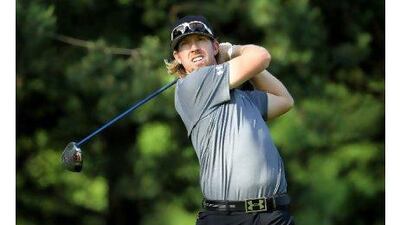Except for the massive grandstands and an endless stream of shuttle buses, much about the Congressional Country Club looks the same as it did the last time Hunter Mahan was here.
That was for the 2009 AT&T National, when Mahan shot a final round 62 and finished one shot behind Tiger Woods.
But that was a regular PGA Tour event. This is the US Open.
So when Mahan was asked whether anyone could shoot a 62 this week - no one has ever done better than 63 at a US Open - he actually thought about it.
And then he thought some more. "Yeah," he finally said. "At this point, it seems possible."
Left unclear was whether "at this point" referred to Monday, the first full day of practice for the US Open, when scores do not count and the greens are not as firm as they tend to be when the competition gets under way tomorrow.
But overall, Congressional is getting favourable reviews as a stern but fair test. That is different from what Mahan has seen at other US Opens, such as Oakmont in Pittsburgh in 2007, his first as a professional. Mahan tied for 13th that week despite never posting a round better than two-over-par 72.
"Some US Opens you get to, there's no hope," he said. "But here, you've got three par 5s ... [so] I think there's a lot of birdie holes. Now, you're going to have to play unbelievably. Usually, it's not possible at all. But you could see a really good round out here."
Three players in the 156-man field at the US Open have won at Congressional. Only one of them knows what it takes to win a US Open. That would be Ernie Els, who captured his second US Open title in 1997 at the Bethesda, Maryland, course. When the AT&T National came to Congressional in 2007, KJ Choi won over Steve Stricker. But he knows he will not see the same course this week.
"The course definitely plays different than when I won in 2007," Choi said. "The tee shot ... when you're standing on the tee box, the holes played different. You have to attack differently. They've pulled it back 20, 30 yards on some of the holes, so you actually have to draw your shots, where in 2007, I could fade my shots."
Even so, the experience of winning here in 2007 has helped Choi feel like he knows his way around. He knows where he can miss, and where the big numbers are waiting if he misses in the wrong spot. "I think the key point is whether you're able to hit your second shots and stop it on the green, stick it to the green, stick it to the pin within four or five yards," Choi said. "Once you're able to do that, I think you have a better advantage."
Among the favourites this week - because of the major, not the location - is Lee Westwood, who is No 2 in the world and getting closer to winning his first major. The Englishman had a putt to get into the play-off at Torrey Pines in the 2008 US Open. He had a par putt to get into a British Open play-off at Turnberry a year later, and he had the 54-hole lead in the Masters last year.
"I think if you're a good player, you're going to have disappointments because you're going to be in contention a lot, aren't you?" Westwood said. "You're going to have lots of chances to win major championships."
It was not always that way for Westwood. Even though he rose to No 4 in the world earlier in his career, he did not start getting seriously close until a few years ago. His first US Open happened to be in 1997 at Congressional.
"The toughness of a US Open set-up takes you by surprise when you've never played it before," Westwood said, "and I really don't remember a lot from 1997, other than it was quite wet. There wasn't a lot of run of the fairways, and it played quite long. I did all right. I finished 19th, so I was quite pleased with that for a first effort at a US Open."
For the players who have not been back in 14 years - Els and Westwood among them - there are a few big changes. The par-3 18th is played in a different direction and now is No 10. Considering it is a two-tee start for the opening two rounds, it will be the third course in the last 10 years when players start a round on a par 3. The others were Royal Lytham, St Annes and Winged Foot.
"There's no tricks to this golf course," Westwood said. "You could almost turn up on Thursday and just play it because it's such a good, honest test."

